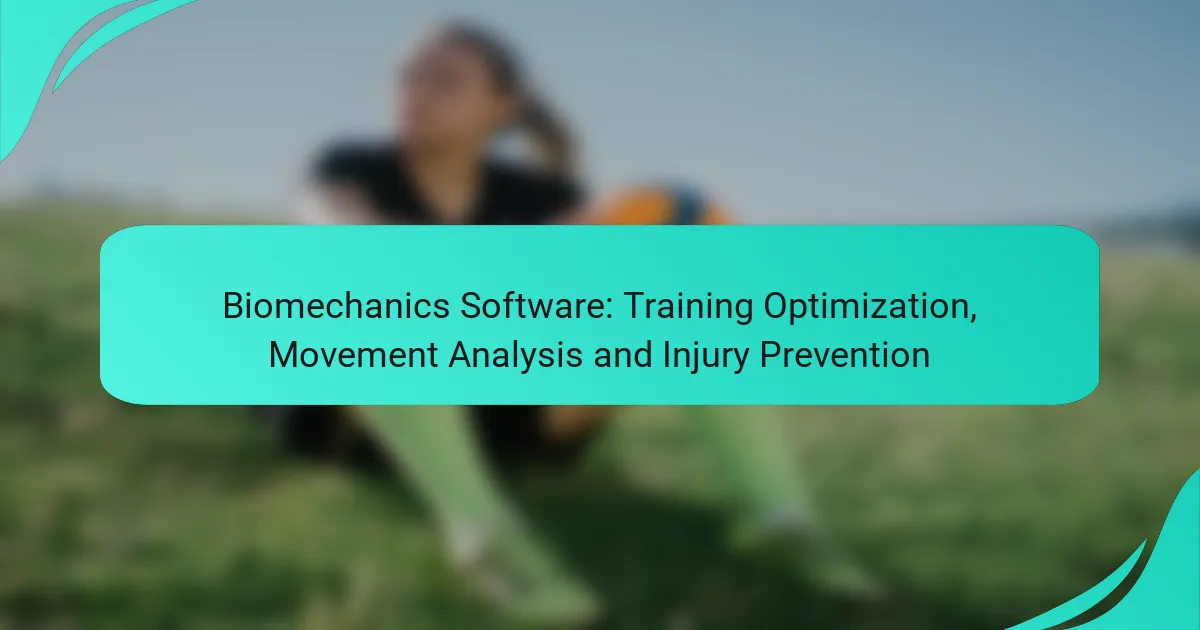Biomechanics software is essential for optimizing training, enhancing performance, and preventing injuries in athletes. By providing detailed movement analysis and personalized insights, these tools enable coaches and athletes to make informed decisions that improve efficiency and safety. With advanced algorithms for modeling human motion, biomechanics software identifies potential injury risks and facilitates tailored interventions to promote long-term athletic health.

How can biomechanics software optimize training in the UK?
Biomechanics software can significantly enhance training in the UK by providing precise movement analysis, performance tracking, and personalized insights. These tools help athletes and coaches make data-driven decisions to improve performance and reduce injury risk.
Performance tracking tools
Performance tracking tools measure various metrics such as speed, strength, and endurance during training sessions. These metrics allow athletes to monitor their progress over time, helping to identify strengths and weaknesses. For example, a runner might use software to track their pace and stride length, enabling targeted improvements.
Many of these tools can integrate with wearable technology, providing real-time data during workouts. This integration can help athletes adjust their training intensity based on immediate feedback, ensuring they stay within optimal performance zones.
Personalized training plans
Personalized training plans created with biomechanics software take into account an athlete’s unique physical attributes and performance goals. By analyzing data from previous sessions, the software can suggest tailored workouts that focus on specific areas for improvement, such as strength training for a sprinter or endurance workouts for a long-distance runner.
These plans can also adapt over time based on ongoing performance data, ensuring that athletes continually progress without risking overtraining. For instance, if an athlete’s recovery times are increasing, the software can recommend adjustments to their training load.
Real-time feedback systems
Real-time feedback systems provide immediate insights during training, allowing athletes to make instant adjustments to their technique. This can be particularly beneficial in sports where form is critical, such as weightlifting or gymnastics. For example, a coach can use biomechanics software to analyze an athlete’s posture and provide corrections on the spot.
These systems often utilize video analysis and motion capture technology to deliver actionable feedback. Athletes can see their movements in real-time, helping them to refine their techniques and avoid developing bad habits that could lead to injuries.
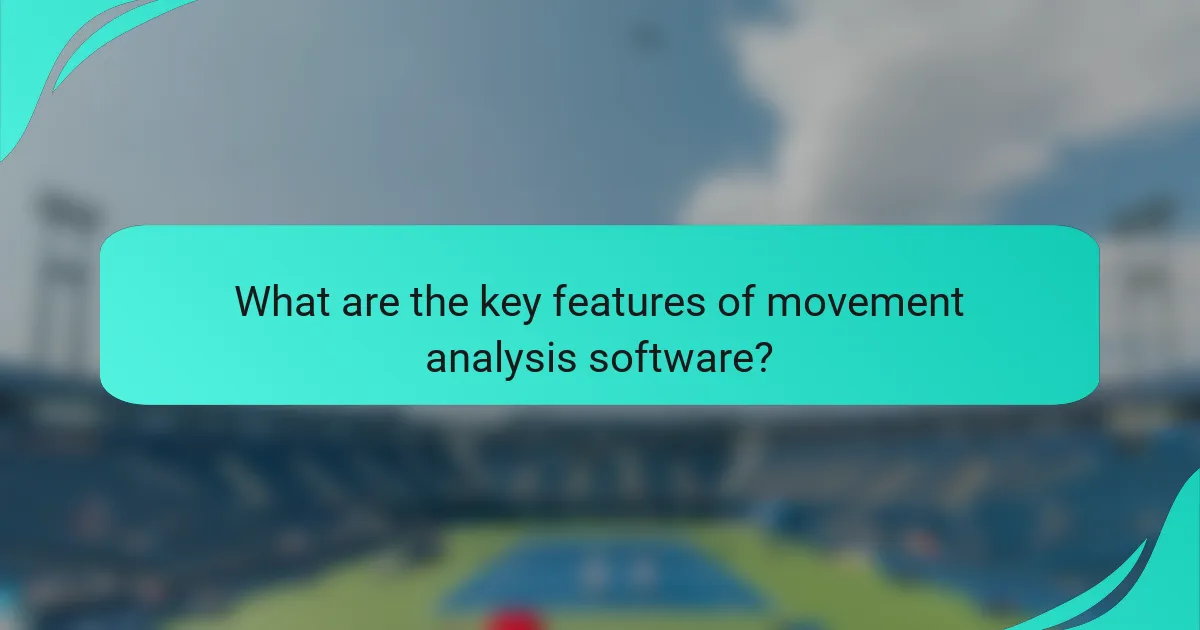
What are the key features of movement analysis software?
Movement analysis software typically includes advanced tools for capturing, modeling, and visualizing human motion. These features help in optimizing training, analyzing performance, and preventing injuries by providing detailed insights into biomechanics.
3D motion capture technology
3D motion capture technology records the movement of athletes in three-dimensional space using specialized cameras and sensors. This technology allows for precise tracking of joint angles and body positions, which is essential for accurate movement analysis.
Common systems utilize reflective markers placed on the body, which are tracked by multiple cameras. This setup can capture movements in real-time, providing immediate feedback for athletes and coaches.
Biomechanical modeling
Biomechanical modeling involves creating digital representations of the human body to simulate and analyze movement patterns. These models can help identify inefficiencies in technique and potential injury risks by examining forces acting on the body during various activities.
Software often uses mathematical algorithms to predict how changes in movement can affect performance and injury risk. For instance, adjusting a runner’s stride length can be modeled to find the optimal balance between speed and injury prevention.
Data visualization tools
Data visualization tools transform complex biomechanical data into understandable graphics and charts. These tools help coaches and athletes quickly interpret results and make informed decisions about training adjustments.
Common visualizations include graphs of joint angles over time, heat maps of muscle activation, and comparison charts of performance metrics. Effective visualization can highlight trends and anomalies that might not be evident in raw data.

How does biomechanics software aid in injury prevention?
Biomechanics software plays a crucial role in injury prevention by analyzing movement patterns and identifying potential risks. By utilizing advanced algorithms and data analysis, these tools help practitioners develop tailored interventions to minimize injury likelihood.
Risk assessment algorithms
Risk assessment algorithms evaluate an individual’s biomechanics to predict injury susceptibility. These algorithms analyze various factors, such as muscle strength, flexibility, and previous injury history, to assess risk levels. For instance, a software tool might flag an athlete with a history of ankle sprains if their current movement patterns suggest instability.
To effectively use these algorithms, practitioners should ensure they are calibrated to the specific population being assessed. Regular updates and validation against current research can enhance accuracy and reliability.
Movement pattern analysis
Movement pattern analysis involves examining an individual’s biomechanics during various activities to identify inefficient or harmful techniques. This analysis can reveal issues like improper gait, poor posture, or unbalanced movements that may lead to injuries. For example, a runner’s software analysis might highlight overpronation, prompting corrective strategies.
Utilizing video capture and motion sensors, biomechanics software provides visual feedback that can be invaluable for both athletes and coaches. This feedback allows for immediate adjustments and long-term improvements in technique.
Rehabilitation tracking
Rehabilitation tracking software monitors an individual’s progress during recovery from an injury. By regularly assessing movement quality and strength, these tools help ensure that patients adhere to their rehabilitation protocols. For example, a physical therapist might use software to track range of motion improvements in a post-surgery patient.
Effective rehabilitation tracking should include goal-setting features and reminders for exercises. This can help maintain motivation and accountability, reducing the risk of re-injury during the recovery phase.
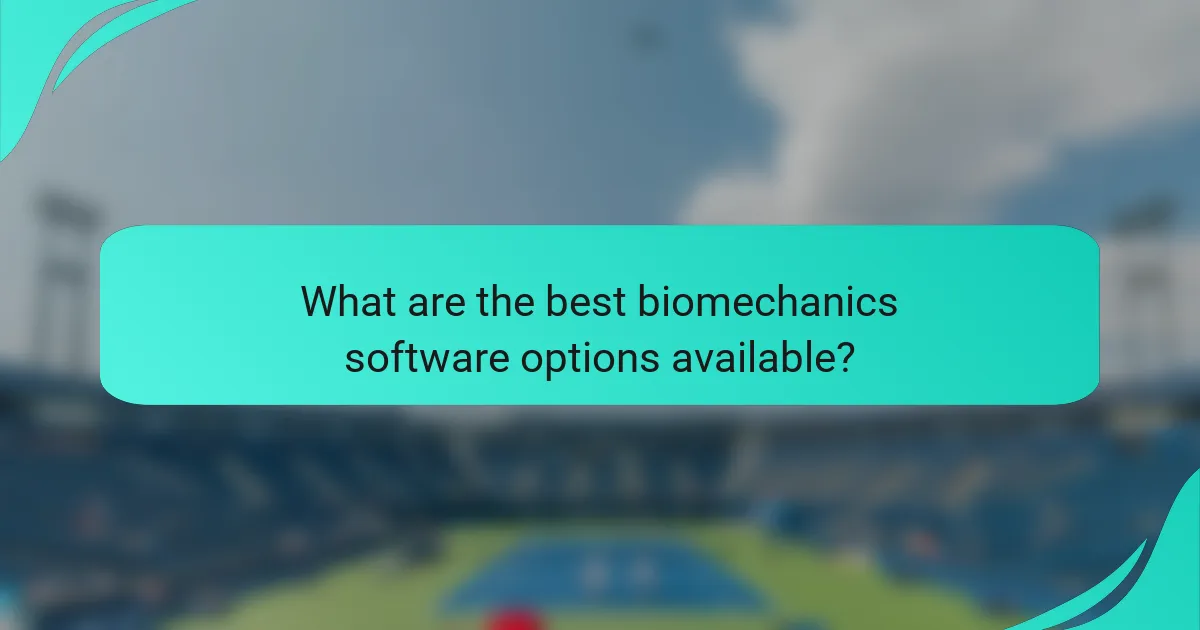
What are the best biomechanics software options available?
The best biomechanics software options provide tools for training optimization, movement analysis, and injury prevention. Key players in this field include Vicon Nexus, Qualisys, and Motion Analysis Corporation, each offering unique features tailored to different user needs.
Vicon Nexus
Vicon Nexus is a leading biomechanics software designed for motion capture and analysis. It excels in providing real-time feedback and comprehensive data visualization, making it ideal for researchers and clinicians focused on gait analysis and sports performance.
When using Vicon Nexus, consider its integration capabilities with various hardware systems, allowing for flexible setups. The software supports a wide range of marker configurations, which can enhance the accuracy of movement assessments.
Qualisys
Qualisys offers a robust biomechanics software solution that emphasizes ease of use and powerful analysis tools. It is particularly favored for its 3D motion capture capabilities, which are beneficial for both clinical and athletic applications.
One of the key advantages of Qualisys is its cloud-based data management, enabling users to access and share data remotely. This feature is especially useful for teams working in different locations or for telehealth applications.
Motion Analysis Corporation
Motion Analysis Corporation provides advanced biomechanics software that focuses on high-speed motion capture and analysis. It is well-suited for professional sports teams and research institutions that require precise measurements of dynamic movements.
Users should note the software’s compatibility with various camera systems and its ability to handle complex motion scenarios. This flexibility allows for detailed assessments, which can inform training regimens and injury prevention strategies effectively.
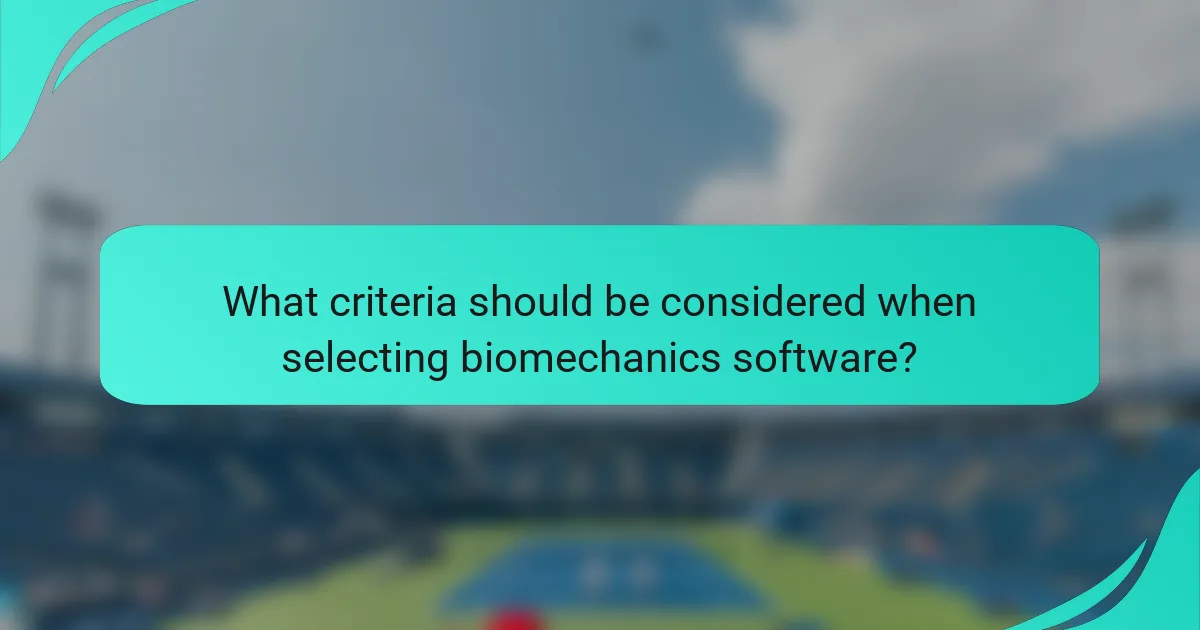
What criteria should be considered when selecting biomechanics software?
When selecting biomechanics software, consider compatibility with existing systems, user interface and experience, and cost and licensing options. These factors will significantly impact how effectively the software can be integrated into your training or rehabilitation programs.
Compatibility with existing systems
Ensure the biomechanics software can seamlessly integrate with your current hardware and software systems. This compatibility will facilitate data sharing and streamline workflows, reducing the need for extensive retraining or additional investments in new equipment.
Check for compatibility with commonly used systems such as motion capture devices, force plates, and wearable sensors. A software solution that supports standard file formats will make it easier to import and export data.
User interface and experience
A user-friendly interface is crucial for maximizing the effectiveness of biomechanics software. Look for intuitive navigation, clear labeling, and customizable dashboards that allow users to access frequently used features quickly.
Consider the learning curve associated with the software. A system that offers tutorials, customer support, and user communities can enhance the overall experience and ensure that users can fully leverage its capabilities.
Cost and licensing options
Evaluate the total cost of ownership, which includes initial purchase price, ongoing maintenance fees, and potential upgrade costs. Some software may offer tiered pricing based on features or user licenses, so assess what best fits your budget and needs.
Look for flexible licensing options, such as subscription models or one-time purchases, to find a solution that aligns with your financial strategy. Additionally, inquire about trial periods to test the software before committing to a purchase.
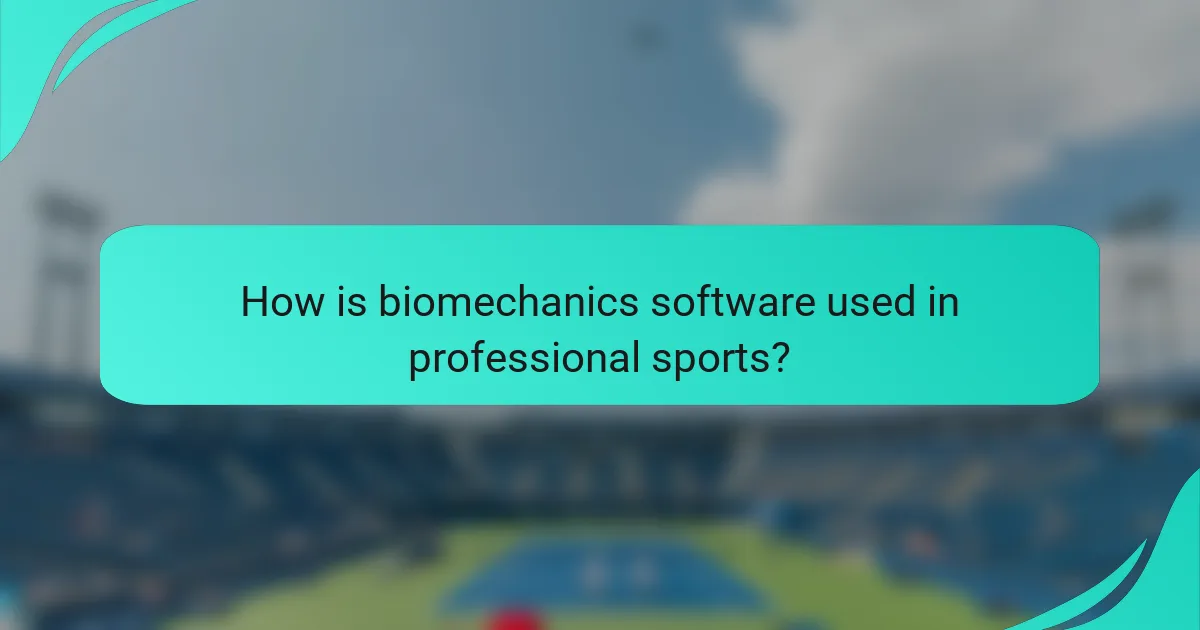
How is biomechanics software used in professional sports?
Biomechanics software is essential in professional sports for optimizing training, analyzing movement, and preventing injuries. It leverages data from motion capture and sensor technologies to provide insights that enhance athletic performance and safety.
Training Optimization
Biomechanics software aids in training optimization by analyzing an athlete’s movements and identifying areas for improvement. By assessing factors such as speed, power, and technique, coaches can tailor training programs to enhance performance effectively.
For example, software can track an athlete’s stride length and frequency, helping coaches adjust training regimens to maximize efficiency. Utilizing this data can lead to improved performance metrics, often resulting in significant gains during competitions.
Movement Analysis
Movement analysis through biomechanics software involves detailed assessments of an athlete’s biomechanics during practice and competition. This analysis helps identify inefficient movement patterns that could lead to decreased performance or potential injuries.
Using high-speed cameras and motion sensors, the software can provide visual feedback on an athlete’s posture, joint angles, and force application. This information allows coaches to make informed adjustments, ensuring athletes maintain optimal biomechanics during their activities.
Injury Prevention
Injury prevention is a critical application of biomechanics software in professional sports. By analyzing an athlete’s movement patterns, the software can detect risk factors associated with injuries, such as improper technique or muscle imbalances.
For instance, if an athlete exhibits excessive knee valgus during a jump, the software can highlight this issue, prompting targeted interventions. Regular assessments can help monitor changes over time, ensuring that athletes remain healthy and competitive.
